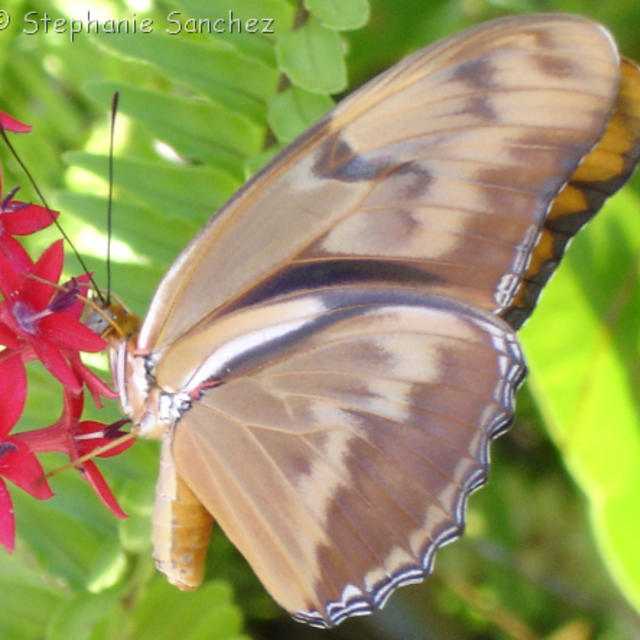Julia Heliconian
Dryas iulia (Fabricius, 1775)
Family: Nymphalidae
Subfamily: Heliconiinae
Identification: Forewings elongate. Male bright orange above and below; upperside of hindwing with narrow black border on outer margin. Female duller orange, with more black markings above.
Wing Span: 3 1/4 - 3 5/8 inches (8.2 - 9.2 cm).
Life History: Males patrol all day for receptive females. Eggs are laid singly on new growth; caterpillars feed on leaves. Adults forage along a set route of nectar sources each day in a behavior known as "trap-lining".
Flight: Throughout the year in southern Florida and South Texas, strays to the north in summer.
Caterpillar Hosts: Passion-vines including Passiflora lutea in Texas.
Adult Food: Nectar from flowers including lantana and shepherd\'s needle; probably others.
Habitat: Subtropical hammock openings and edges, and nearby fields.
Range: Resident in Brazil north through Central America, Mexico, West Indies, peninsular Florida, and South Texas. Strays north to eastern Nebraska.
Conservation: Not usually required, but habitat in South Texas is limited.
NCGR: G5 - Demonstrably secure globally, though it may be quite rare in parts of its range, especially at the periphery.
Management Needs: None reported.
Please donate!
We depend on donations to keep Butterflies and Moths of North America freely available. We want to express our gratitude to all who showed their support by making a contribution this year. You can donate to support this project at any time.
Advertise with us!
Do you have a product or service that you think would interest BAMONA users? If you would like to advertise on this website, contact us by email, or use the contact form and select the "Advertising" category.
Verified Sightings
Displaying 1 - 24 of 357 verified sightings

Observation date: Nov 14, 2025
Submitted by: islandgyal
Region: The Bahamas
Verified by: John Calhoun
Verified date: Nov 17, 2025

Observation date: Oct 06, 2025
Submitted by: Charlie Doggett
Region: Costa Rica
Verified by: Charlie Doggett
Verified date: Oct 23, 2025

Observation date: Aug 06, 2025
Submitted by: Charlie Doggett
Region: Costa Rica
Verified by: Charlie Doggett
Verified date: Aug 28, 2025

Observation date: Jul 18, 2025
Submitted by: Charlie Doggett
Region: Costa Rica
Verified by: Charlie Doggett
Verified date: Aug 08, 2025

Observation date: Jul 06, 2025
Submitted by: Mendrola
Region: Costa Rica
Verified by: Charlie Doggett
Verified date: Jul 17, 2025

Observation date: Jul 04, 2025
Submitted by: Charlie Doggett
Region: Costa Rica
Verified by: Charlie Doggett
Verified date: Jul 17, 2025

Observation date: Mar 22, 2013
Submitted by: Dwaine Wagoner
Region: Miami-Dade County, Florida, United States
Verified by: John Calhoun
Verified date: Jul 02, 2025

Observation date: May 27, 2025
Submitted by: therapypetz
Region: Broward County, Florida, United States
Verified by: John Calhoun
Verified date: May 28, 2025
Observation date: Jan 22, 2025
Submitted by: hasfitz5
Region: Corozal District, Belize
Verified by: Charlie Doggett
Verified date: May 19, 2025

Observation date: May 08, 2025
Submitted by: Charlie Doggett
Region: Costa Rica
Verified by: Charlie Doggett
Verified date: May 19, 2025

Observation date: May 01, 2025
Submitted by: therapypetz
Region: Broward County, Florida, United States
Verified by: John Calhoun
Verified date: May 02, 2025

Observation date: Apr 18, 2025
Submitted by: hockeybruce7
Region: Miami-Dade County, Florida, United States
Verified by: John Calhoun
Verified date: Apr 28, 2025

Observation date: Nov 24, 2024
Submitted by: Robert Gorman
Region: Hidalgo County, Texas, United States
Verified by: jwileyrains
Verified date: Dec 03, 2024

Observation date: Nov 03, 2024
Submitted by: Charlie Doggett
Region: Costa Rica
Verified by: Charlie Doggett
Verified date: Nov 13, 2024

Observation date: Nov 02, 2024
Submitted by: Paul Prappas
Region: Hidalgo County, Texas, United States
Verified by: jwileyrains
Verified date: Nov 12, 2024

Observation date: Nov 06, 2024
Submitted by: Charlie Doggett
Region: Costa Rica
Verified by: Charlie Doggett
Verified date: Nov 07, 2024

Observation date: Nov 01, 2024
Submitted by: marilynne
Region: Palm Beach County, Florida, United States
Verified by: John Calhoun
Verified date: Nov 06, 2024

Observation date: Nov 04, 2024
Submitted by: princessmarilyn
Region: Harris County, Texas, United States
Verified by: jwileyrains
Verified date: Nov 04, 2024

Observation date: Oct 22, 2024
Submitted by: Charlie Doggett
Region: Costa Rica
Verified by: Charlie Doggett
Verified date: Nov 03, 2024

Observation date: Oct 28, 2024
Submitted by: theskyeworld
Region: Bastrop County, Texas, United States
Verified by: jwileyrains
Verified date: Oct 28, 2024

Observation date: Oct 19, 2024
Submitted by: jmgesell
Region: Miami-Dade County, Florida, United States
Verified by: John Calhoun
Verified date: Oct 23, 2024

Observation date: Oct 21, 2024
Submitted by: jmgesell
Region: Broward County, Florida, United States
Verified by: John Calhoun
Verified date: Oct 23, 2024
Observation date: Oct 19, 2024
Submitted by: Sapper Dan
Region: Bell County, Texas, United States
Verified by: jwileyrains
Verified date: Oct 21, 2024

Observation date: Oct 04, 2024
Submitted by: Charlie Doggett
Region: Costa Rica
Verified by: Charlie Doggett
Verified date: Oct 19, 2024
- 1 of 15
- next ›

















